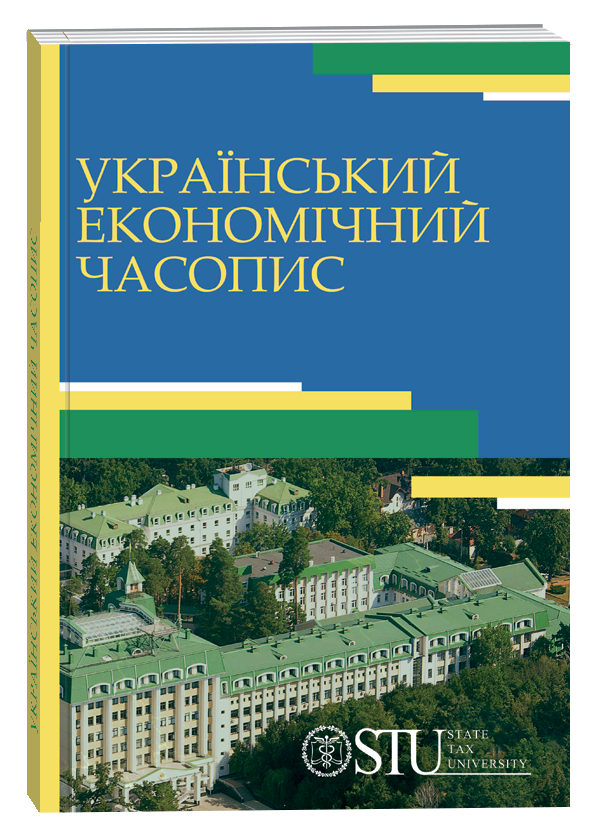CORPORATE TAX AS TAX POLICY REGARDING DIRECT TAXATION IN EU COUNTRIES
DOI:
https://doi.org/10.32782/2786-8273/2024-7-7Keywords:
corporate tax, corporation, direct taxation, tax, taxationAbstract
Introduction. Tax law aims to effectively regulate the system of relations that arise in connection with the payment of taxes and fees. To this day, discussions are held in academic circles regarding the concept of tax law, and also whether this is a separate branch of law or a sub-branch of financial law. Some of the scientists justify that tax law is an institution of financial law, which aims to regulate the formation of the revenue part of budgets, its regulatory effect is extended only to relations that arise during the movement of funds from taxpayers and fees to budgets of different levels. The purpose of the article is to analyze the characteristics of corporate tax as a tool of tax policy regarding direct taxation in EU countries, as well as to assess its impact on economic indicators and the business environment in these countries. To write the article, the following methods are used: comparative analysis of tax policies, statistical data analysis, literature review, historical method, case studies, empirical analysis, and comparison of legislative norms, which allows for a comprehensive study of corporate tax in the EU. Results. At first it seems that harmonizing the tax legislation of the EU countries in terms of direct taxation is a simpler task than harmonizing indirect taxes, since, unlike indirect taxation, direct taxation was used in every EU member state. However, as it turned out later, each individual country used its own tax base and set tax rates, taxpayers, benefits, etc. differently. At the first priority stage, the European Commission indicated a minimum corporate tax rate of 30% for profit and for distributed profit in the form of dividends. At the secondary stage – 40%. Conclusion. General harmonization of direct and indirect taxes deprives countries of influence on their own economies and may be a factor in reducing the revenue base of the budgets of countries in which higher tax rates were applied. The EU goals for general harmonization have failed. At the first stage, harmonization was necessary as a tool for the formation of a single market, and at the current stage, rather, as a tool for combating tax evasion.
References
Брехов С.С. Актуальні проблеми теорії та практики оподаткування. Ірпінь : Нац. ун-т ДПС України, 2013. 553 с.
Визначення ставок податку на прибуток підприємств URL: https://zp.tax.gov.ua/media-ark/news-ark/752017.html (дата звернення: 28.04.2024).
Велика сімка домовилася про глобальний податок для великих корпорацій. 2021 URL: https://www.ukrinform.ua/rubric-world/3259579-velika-simka-domovilasa-pro-globalnij-podatok-dla-velikih-korporacij.html (дата звернення: 28.04.2024).
ЄС запровадив мінімальну ефективну ставку оподаткування 15% для транснаціональних компаній. 2024 URL: https://biz.ligazakon.net/news/224630_s-zaprovadiv-mnmalnu-efektivnu-stavku-opodatkuvannya-15-dlya-transnatsonalnikh-kompany#:~:text= (дата звернення: 28.04.2024).
Податкове право країн ЄС / Волощук М.Г., Петріченко О.О., Білаш О.В., Карабін Т.О., Менджул М.В. Ужгород, 2021. 143с.
Про ставки податку на прибуток підприємств в 2023 році URL: https://medoc.ua/blog/pro-stavki-podatku-na-pributok-pidprimstv-v-2023-roci-#:~:text=136.1 (дата звернення: 28.04.2024).
Thomas Belz, Dominik von Hagen, Christian Steffens. Taxes and firm size: Political cost or political power? Journal of Accounting Literature. 2019. Vol. 42. P. 1–28.
Gogol, TA Tax methods of regulating the development of small business in the developed world. Scientific Bulletin of Polissya. 2017. № 1 (9). Part 1. P. 87–92.
Halunko V., Halunko V., & Savyuk М. Foreign experience for financing small and medium business. Baltic Journal of Economic Studies. 2018. No. 4(5). P. 40–45. DOI: https://doi.org/10.30525/2256-0742/2018-4-5-40-45
Williams C.C. Cross-country variations in the participation. Journal of Small Business and Enterprise Development. 2016. Vol. 23. Is. 1. P. 3–24.
Brekhov S. S., (2013) Aktualni problemy teorii ta praktyky opodatkuvannia [Actual problems of the theory and practice of taxation.] Monohrafiia. Irpin: Nats. un-t DPS Ukrainy. (in Ukranian)
Vyznachennia stavok podatku na prybutok pidpryiemstv [Determination of corporate income tax rates]. Available at: https://zp.tax.gov.ua/media-ark/news-ark/752017.html (in Ukranian)
Velyka simka domovylasia pro hlobalnyi podatok dlia velykykh korporatsii [The G7 agreed on a global tax for large corporations]. Available at: https://www.ukrinform.ua/rubric-world/3259579-velika-simka-domovilasa-pro-globalnij-podatok-dla-velikih-korporacij.html (in Ukranian)
YeS zaprovadyv minimalnu efektyvnu stavku opodatkuvannia 15% dlia transnatsionalnykh kompanii [The EU introduced a minimum effective tax rate of 15% for multinational companies]. Available at: https://biz.ligazakon.net/news/224630_s-zaprovadiv-mnmalnu-efektivnu-stavku-opodatkuvannya-15-dlya-transnatsonalnikh-kompany#:~:text= (in Ukranian)
Voloshchuk M.G., Petrichenko O.O., Bilash O.V., Karabin T.O., Menzhul M.V. (2021) Podatkove pravo krain YeS [Tax law of EU countries] Uzhhorod. (in Ukranian)
Pro stavky podatku na prybutok pidpryiemstv v 2023 rotsi [About corporate income tax rates in 2023]. Available at: https://medoc.ua/blog/pro-stavki-podatku-na-pributok-pidprimstv-v-2023-roci-#:~:text=136.1
Belz T., Hagen D., & Steffens C. (2019) Taxes and firm size: Political cost or political power? Journal of Accounting Literature, vol. 42, pp. 1–28.
Gogol T. A., & Volot O. I. (2017) Tax methods regulating the development of small businesses in the developed world. Scientific Bulletin of Polissia, no. 1 (9), pp. 87–92.
Halunko V., Halunko V., & Savyuk М. (2018) Foreign experience for financing small and medium business. Baltic Journal of Economic Studies, no. 4(5), pp. 40–45. DOI: https://doi.org/10.30525/2256-0742/2018-4-5-40-45
Williams C. C., & Horodnic I. A. (2016) Cross-country variations in the participation of small businesses in the informal economy: An institutional asymmetry explanation. Journal of Small Business, vol. 23, is. 1, pp. 3–24.



